
Science in Hinduism-Place value and Decimal number system
If I ask you what is mankind greatest invention? If Mobiles, Bombs, laptops, space research are one of your answers, then logically, you are wrong. All these answers are just a few outcomes of human greatest invention. If this is the case then the question still remains “What is human greatest invention”. According to me, human’s greatest invention is language, both spoken and written, which forms the basic means of communication, representation, demonstration, expression etc among all humans. This language forms the basis of every other invention because without language, no other invention can be created, expressed, or explained to others. Even the machines are incomplete without language For Ex: Computers and most mechanical equipment internally work on binary language. When we are talking about language, then how can we forget the language of mathematics without which, none of the modern discoveries can be explained precisely. Even binary language is part of mathematics. Mathematical notation, mathematical formula, mathematical units etc are used for all modern inventions or is a part of all modern discoveries. All modern hi-fi equipments and devices internally perform intensive mathematical calculations to do its various activities and finally give you a better, easily understandable, eye-catching presentable output.
In short, I guess it is worth knowing how the present number system and the various mathematical operations/calculations came into existence. So, in this article, we will explore one of mankind’s greatest inventions, PLACE VALUE SYSTEM or DECIMAL NUMBER SYSTEM
History of number system
Origin of number system is attributed to many civilizations like Babylonians, Chinese, Mayans, and Egyptians and as per the common perceptions among historians, Babylonians and Chinese number system is the most primitive of all civilizations. Babylons invented the base 60 place value system whereas Chinese used counting rods and dots as their number system while Mesoamerican used the vigesimal (base 20) number system. Some of the western historians claims that Indian adapted the Babylon base 60 number system into their own number system to give our present decimal number system whereas Chinese historians claims that Indian used the Chinese method of counting rods to invent decimal number system. However as per the latest evidences available, Indians developed a number system on its own without looking into other civilization number system and Indian numeral system pre-dated both the Chinese and Babylon’s number system.
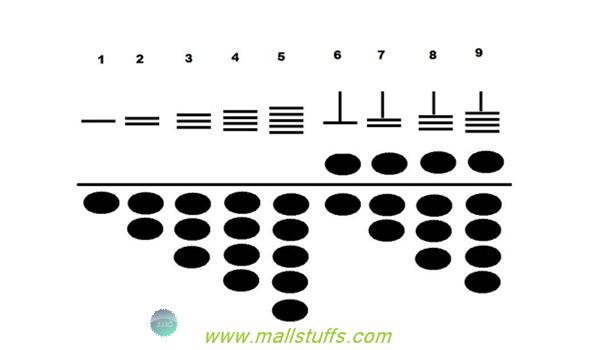
Chinese counting system
Positional number system in Vedas
There is a concept of positional number system in Vedas (Indian Sacred text) which has been proven scientifically at least 10,000 years old(As per religious belief, Vedas were gifted to humans by gods millions of years ago).
Vedas contains hymns in the form of poetry. So, it does not have any symbol or mathematical notation to represent place value system. Instead it used words to define large number and a list of such words can be found in my previous article (Click here to view article ). Yajurveda, second of four Vedic texts predates Greek and Chinese mathematicians by at least a millennium, and has names upto 10^53. Not only there are words for the units ten, hundred and thousand, it also has words for units ‘ten thousands’, lakhs, millions, crores, etc. Words used to denote ten, hundred, thousand, millions, crores, billions are daza, zata, sahasra, ayuta, laksa and vyarbuda respectively, going up to 10^ 53.

Some of the large numbers used in Indian ancient texts
Using above words as notation, 50,681 is written as panchim (50), sahasra (thousand), sat (Six) satani (hundred), ashteem (eight ten times) and eka (One).
Partial vocabulary of such notations is as follows:
1. First nine digits (eka, dvi, tri, catur, pancha, sat, sapta, ashta, nava);
2. Digit at ten’s place or digit obtained by multiplying ten to the first nine digits (dasa, vimsat, trimsat, catvarimsat, panchasat, sasti, saptati, astiti, navati): and
3. Number in powers of 10 starting with 10^2 (satam sahasara, ayut, niyuta, prayuta, arbuda, nyarbuda, samudra, Madhya, anta, parardha...).
Vedas influenced decimal Number system
Base 10 System, which uses nine numerals and zero, to represent the minutest numbers in fractions, and extremely large numbers in powers of 10. Such a system was not developed by Greeks, where largest unit of enumeration was myriad (10,000) or China, where the same 10,000 was the largest number of enumeration.
Idea of decimal number system was taken from Vedas and not from other civilizations. Those days, Indians were so advanced that they never have to look on other civilizations, instead since India was center of learning and education, scholars of other countries would come to India for their education and spiritual development.
Many Indian mathematicians decoded Vedas and started using symbol and notations to represent decimal numbers. This became the foundation of modern notational place value system with the oldest document dated to 594 AD, a donation charter of Ruler Dadda III of Sankheda (Bharukachcha region).
However the most significant achievement in the field of decimal number system is attributed to Aryabhata who said “Sthanam sthanam dasa gunam” which literally translates as (“place to place in ten times in value”). He was the first to derive the value of pi up to ten decimal digits. Works of Aryabhata was said to be the re-introduction of Indian decimal system which later became the modern decimal number system.
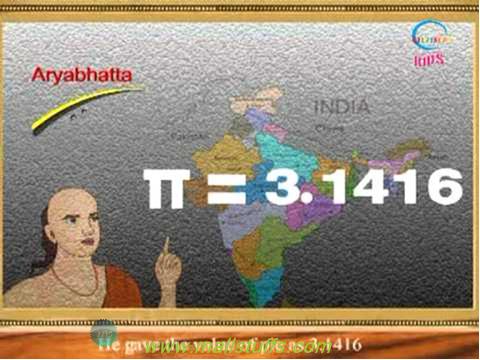
Aryabhata and his invention
When Decimal number system was invented?
It is undeniable that the Babylonians has a place value system in place, but the fact is they invented a faulty sexagismal (base 60) number system based on units of time i.e. hrs, mins and secs, whereas Indians invented the correct decimal number system (base 10).
There is no correct date on when the decimal number system was invented because the Indian sages and mathematicians did their work for spiritually, dedicated all their work to god and never took the credit of their work on themselves. Moreover, oral mode of learning was given more importance than written mode of learning. Hence, there is very less evidences found in ancient Indian literature but given the advancement and superiority of ancient Indian scriptures, no one can straightly deny that Indians didn’t know the decimal system millions of years ago and were not the first civilization to have advanced decimal number system. Preserving knowledge in written forms gained importance in Tretayuga when sages thought of preserving and disseminating knowledge through written mode. Some of the important written texts of India are from the sutra style of writing, which presented information in form of syllables or poetic cryptic form, leaving out descriptive details. Morals and rationale of the verses was left to be deduced by the teachers or speaker addressing the students. Information was well expressed in short poetic sentences so that the reader cans memorize the content easily. Whatever the case is, Indian decimal number system is at least 5000 years old because many seals with symbols of 10, 20, 100 etc were found in recent excavations at harrapa and mohen jo daro, which are the sites of Indus valley civilization.
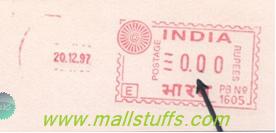
Indian postal stamp acknowledging their invention of decimal number system
How Indian Decimal number system reached West
As per the evidence available, Indian decimal number reached west through arabs. Arab scholar and mathematician al-Biruni shared his works and research on mathematics with Europeans scholars. His works first reached Italy and from Italy, it reached rest of Europe.
The further enhancements and adaptation of Indian decimal numbers by other cultures Prompted Arab scholar and mathematician al-Biruni to document his works and research on Indian number system. He mentions the following words in his book (dated 1020 AD).
“Whilst we use letters for calculation according to their numerical value, the Indians do not use letters at all for arithmetic. And just as shape of the letters that they use for writing is different in different regions of their country, so the numerical symbols vary”. “What we (the Arabs) use for numerals is a selection of the best and most regular figures in India”.
Slowly and gradually, all other civilization abandoned their counting technique and adapted to Indian decimal number system and by the 10th century AD, thanks to the Arabs, Indian decimal system reached all parts of this world.
Noted mathematicians like Joseph and Freudenthal also supports the theory that the idea of positional number system came entirely from india and to explain his point, he took the example of Buddhist text Lalitavistara, dated 2nd century AD, where Gautama Buddha (Founder of Buddhism) not only used large numbers but also described many complex mathematical operations.
Joseph believed Indians fascination with large numbers influenced them to invent a positional number system to easily express all fractional numbers. He said
“The early use of such large numbers eventually led to the adoption of a series of names for successive powers of ten. The importance of these number names cannot be exaggerated. The word-numeral system, later replaced by an alphabetic notation, was the logical outcome of proceeding by multiples of ten. The decimal place-value system developed when a decimal scale came to be associated with the value of the places of the numbers arranged left to right or right to left. And this was precisely what happened in India.”
Same story of Lalitavistara also convinced another renowned mathematician Kaplan but he believed that the idea of number system came from the Greeks. Whatever the case is and however the place value system was invented, the undisputed point is Indians invented the present decimal base number system and was transmitted to Europe through arabs.
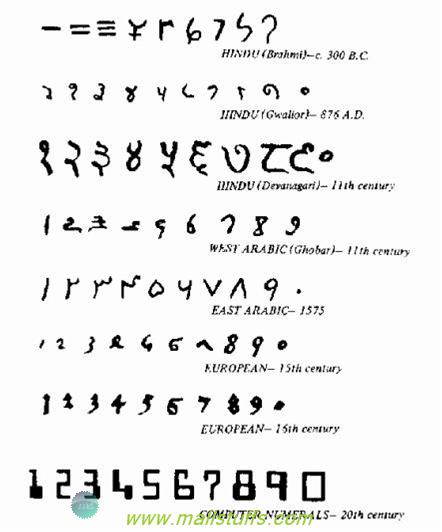
Evolution of Indian number system
False claims by other countries
As said before, Indian decimal number system got attention by Arabs in the eighth century AD, when al-Khwarizmi translated various Indian mathematical concepts in his works. It reached Europe in the 12th century AD when Adelard of Bath translated al-Khwarizmi's books into Latin. Arab scholar Mohammed ibn-Musa al-Khwarizmi, who brought the Indian number system to the west, gave full credit to Indians for their decimal numbers system, but many religious Arabs fundamentalist later tried to claim decimal number system as their own.
Citing the Arabs claims of inventing positional number system, famous European mathematician Laplace said
...During the earlier decades of this century (20th) attempts were made to credit this invention wholly or in part to the Arabs. [CS, P 2]
He also admired the Indian decimal number system through the following words
...The idea of expressing all quantities by nine figures whereby is imparted to them both an absolute value and one by position is so simple that this very simplicity is the very reason for our not being sufficiently aware how much admiration it deserves. [CS, P 5]
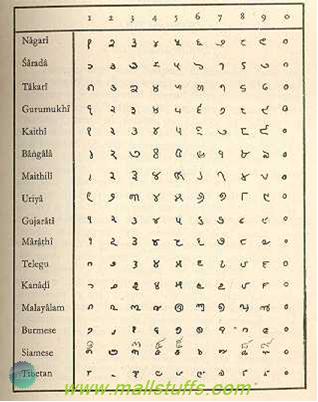
Indian number system in various Indian and Asian languages
On this issue, Indian mathematician C Srinivasiengar writes:
...During the earlier decades of this century (20th) attempts were made to credit this invention wholly or in part to the Arabs. [CS, P 2]
Europeans too were at first reluctant to this system but because of the limitations of roman number system, eventually, they had to adopt the Indian number system.
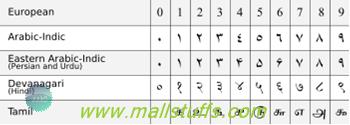
Adaptation of Indian numerals by other civilizations
Beside these, many attempts were made to discredit Indians of their decimal number with the latest being Sweden who abolished the decimal number system in their co9untry in the early 18th century. On this, mathematician G Halstead said:
...The importance of the creation of the zero mark can never be exaggerated. This giving to airy nothing, not merely a local habituation and a name, a picture, a symbol but helpful power, is the characteristic of the Hindu race from whence it sprang. No single mathematical creation has been more potent for the general on go of intelligence and power. [CS, P 5]
In short, as it is said, time and time again, India is the cradle of all civilization and given the number of evidences coming up, there is no point denying the superiority and advancement of Indians among all other civilized cultures.
India lost its credibility and importance, courtesy of continuous looting by foreign rulers, first mughals, then British and today our own evil corrupt politicians. However, lord Krishna said “After 5000 years of KailYuga, golden age will start and will remain for ten thousand years”.
As per the Indian calendar, that golden age is very near and India would start retaining his lost glory gradually starting next year (I would come up with an article on this topic at the end of this year).
I would end this article by quoting French mathematician Pierre Simon Laplace quote on importance of decimal number system:
"It is India that gave us the ingenious method of expressing every possible number using a set of ten symbols (each symbol having a place value and an absolute value) emerged in India. The idea seems so simple nowadays that its significance and profound importance is no longer appreciated. Its simplicity lies in the way it facilitated calculation and placed arithmetic foremost amongst useful inventions."
Note: Images used on this website
are either a production of Bhaktivedanta Book Trust(https://www.krishna.com), Iskcon
Foundation or were found in google search under "Free to use and share". If any
of the images presented here violates copyright issues or infringes anyone copyright
or are not under "Fair use", then please bring it to our notice. Read
Disclaimer for more.
Share this to your friends. One of your friend is
waiting for your share.
Related Articles
Science in Hinduism-Invention of numeral system
Science in Hinduism-Motion of earth around sun
Why Lord krishna had more than 16000 wives
Proof of Lord krishna existence-1
Rama Sethu-Proof of India great ancient science
Swastika in american Food industry
Stories of radha krishna love
Science in Hinduism-Large numbers and infinity
Various Maya-Illusions of lord krishna
Science in Hinduism-Gravitational force and repulsive force
Post Comment